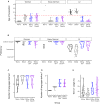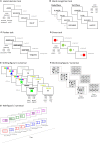Bidialectalism and Bilingualism: Exploring the Role of Language Similarity as a Link Between Linguistic Ability and Executive Control
- PMID: 30405487
- PMCID: PMC6206588
- DOI: 10.3389/fpsyg.2018.01997
Bidialectalism and Bilingualism: Exploring the Role of Language Similarity as a Link Between Linguistic Ability and Executive Control
Abstract
The notion of bilingual advantages in executive functions (EF) is based on the assumption that the demands posed by cross-language interference serve as EF training. These training effects should be more pronounced the more cross-language interference bilinguals have to overcome when managing their two languages. In the present study, we investigated the proposed link between linguistic and EF performance using the similarity between the two languages spoken since childhood as a proxy for different levels of cross-language interference. We assessed the effect of linearly increasing language dissimilarity on linguistic and EF performance in multiple tasks in four groups of young adults (aged 18-33): German monolinguals (n = 24), bidialectals (n = 25; German and Swiss German dialect), bilinguals speaking two languages of the same Indo-European ancestry (n = 24; e.g., German-English), or bilinguals speaking two languages of different ancestry (n = 24; e.g., German-Turkish). Bayesian linear-mixed effects modeling revealed substantial evidence for a linear effect of language similarity on linguistic accuracy, with better performance for participants with more similar languages and monolinguals. However, we did not obtain evidence for the presence of a similarity effect on EF performance. Furthermore, language experience did not modulate EF performance, even when testing the effect of continuous indicators of bilingualism (e.g., age of acquisition, proficiency, daily foreign language usage). These findings question the theoretical assumption that life-long experience in managing cross-language interference serves as EF training.
Keywords: bidialectalism; bilingualism; executive functions; language similarity; linguistic processing.
Figures





Similar articles
-
Balanced bilingualism and early age of second language acquisition as the underlying mechanisms of a bilingual executive control advantage: why variations in bilingual experiences matter.Front Psychol. 2015 Feb 26;6:164. doi: 10.3389/fpsyg.2015.00164. eCollection 2015. Front Psychol. 2015. PMID: 25767451 Free PMC article.
-
The effect of script similarity on executive control in bilinguals.Front Psychol. 2014 Sep 29;5:1070. doi: 10.3389/fpsyg.2014.01070. eCollection 2014. Front Psychol. 2014. PMID: 25400594 Free PMC article.
-
The effect of bilingualism on executive functions when languages are similar: a comparison between Hungarian-Serbian and Slovak-Serbian young adult bilinguals.Mem Cognit. 2023 Apr;51(3):561-581. doi: 10.3758/s13421-022-01345-8. Epub 2022 Jul 29. Mem Cognit. 2023. PMID: 35904724 Free PMC article.
-
The Complex Nature of Bilinguals' Language Usage Modulates Task-Switching Outcomes.Front Psychol. 2016 Apr 25;7:560. doi: 10.3389/fpsyg.2016.00560. eCollection 2016. Front Psychol. 2016. PMID: 27199800 Free PMC article. Review.
-
Not All Bilinguals Are the Same: A Call for More Detailed Assessments and Descriptions of Bilingual Experiences.Behav Sci (Basel). 2019 Mar 24;9(3):33. doi: 10.3390/bs9030033. Behav Sci (Basel). 2019. PMID: 30909639 Free PMC article. Review.
Cited by
-
Orientation towards the vernacular and style-shifting as language behaviours in speech of first-generation Polish migrant communities speaking Norwegian in Norway.Front Psychol. 2024 Aug 14;15:1330494. doi: 10.3389/fpsyg.2024.1330494. eCollection 2024. Front Psychol. 2024. PMID: 39205976 Free PMC article.
-
Exploration of Attentional and Executive Abilities in French-Speaking Children Immersed in Dutch Since 1, 2, 3, and 6 Years.Front Psychol. 2020 Dec 17;11:587574. doi: 10.3389/fpsyg.2020.587574. eCollection 2020. Front Psychol. 2020. PMID: 33391108 Free PMC article.
-
Problematic smartphone usage, objective smartphone engagement, and executive functions: A latent variable analysis.Atten Percept Psychophys. 2023 Nov;85(8):2610-2625. doi: 10.3758/s13414-023-02707-3. Epub 2023 May 15. Atten Percept Psychophys. 2023. PMID: 37188861
-
The association of multilingualism with diverse language families and cognition among adults with and without education in India.Neuropsychology. 2025 Mar;39(3):223-234. doi: 10.1037/neu0000988. Neuropsychology. 2025. PMID: 40063370
-
Does bilingualism come with linguistic costs? A meta-analytic review of the bilingual lexical deficit.Psychon Bull Rev. 2023 Jun;30(3):897-913. doi: 10.3758/s13423-022-02136-7. Epub 2022 Nov 3. Psychon Bull Rev. 2023. PMID: 36327027 Free PMC article. Review.
References
-
- Ameel E., Malt B. C., Storms G., Van Assche F. (2009). Semantic convergence in the bilingual lexicon. J. Mem. Lang. 60 270–290. 10.1016/j.jml.2008.10.001 - DOI
-
- Arthur W., Day D. V. (1994). Development of a short form for the raven advanced progressive matrices test. Educ. Psychol. 54 394–403. 10.1177/0013164494054002013 - DOI
-
- Baddeley A. D. (1986). Working Memory. New York, NY: Oxford University Press.
LinkOut - more resources
Full Text Sources
Research Materials

